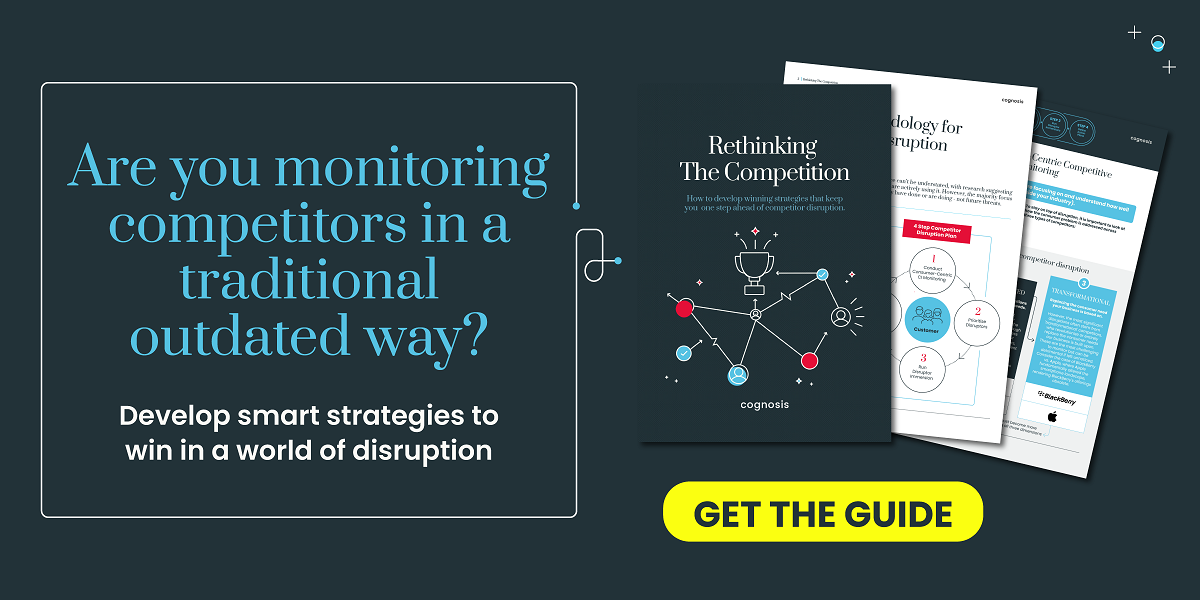Choiceful competitive benchmarking that helps deliver your strategy
Business rivalry used to mean pitched warfare between industry players. Today, new enemies can emerge when least expected, often from outside your own industry, threatening the very existence of your business. In this article we discuss the importance of developing strategic competitive intelligence that turns unforeseen disruption into opportunities for growth.

Competitor benchmarking used to mean scoping out your two or three closest rivals. Now, the rules of engagement have changed. There is a new era of competition. New competitors, armed with innovative ideas and agile business models, challenge traditional players in various industries. This market disruption can leave all players scrambling to keep pace.
The opposite is also true. Those forward-minded businesses that can both read the direction of travel and adapt accordingly will not only survive but also thrive into the future. By redefining who your competition is and viewing competitive activity as a source of partnership and innovation, companies can open new avenues for growth.
> RETHINK YOUR COMPETITION: A practical guide to developing winning strategies that keep you one step ahead of competitor disruption
Widen your periphery vision with strategic intelligence
But understanding the predicament is all very well. How do you turn good intentions into meaningful gains?
While 90% of Fortune 500 companies actively use competitor benchmarking to inform their decision making, the vast majority remains focused on direct competitors, scanning their current activity or taking a retrospective appraisal. What if those known threats are the least of your concerns?
The bear trap for businesses is assuming that they know who their competitor is. This conjecture can lead to a blinkered approach to benchmarking, as it risks omitting the surprise entrants that leave your business most exposed.
In the current era of fierce rivalry, leaders must change their mindset, shifting from a limited focus on competitor intelligence to competitive intelligence. That may sound like semantics, but changing from -or to -ive means your business will survey both expected and unexpected sources of danger.
Competitive benchmarking starts with the consumer problem
So, how to be choiceful, rather than restricted?
By putting the consumer/customer problem front and centre (a good exercise anyway), you can investigate who else is looking to solve that problem in the same or different way. Recent history shows that disruptors typically emerge from the long grass by addressing unmet consumer needs or solving existing problems in better, more innovative ways. In fact, countless entrepreneurs spend every waking hour searching for these disruption opportunities. By taking a consumer-led approach (rather than product-led), you move beyond direct competitors and into a new category labelled ‘future threats’.
Consumer-centric intelligence is three dimensional
To keep ahead of disruption, it’s worth exploring how the consumer problem may be tackled by three distinct breeds of competitor:
- Core
These are your traditional, same-sector competitors that certainly need monitored, but risk drawing you into a state of complacency, as they see the world through a similar lens. The long-running rivalry of Pepsi and Coca-Cola is good example. By concentrating on each other, perhaps, they might have missed the sudden, meteoric rise of Prime, the sports drink propelled to stratospheric heights by social media and celebrity. Prime found a different answer to the problem ‘what young people want’.
2. Differentiated
In the differentiated scenario, the player is disrupted by a newcomer that answers the customer problem in a superior and different way. The competitor adopts a new technology, for example, or comes at the problem from an entirely fresh perspective – that the existing leader either fails to see or dismisses as an insignificant threat. The movie rental chain Blockbuster is a famous case of the latter, losing out to Netflix’s online platform – and even turning down the opportunity to buy them whilst they were in early growth.
3. Transformational
These competitors bring in a totally new business model that gives the consumer something so different that the status quo is forced to change rapidly or subside. They revolutionise or entirely replace the consumer need your business is based on. Predicting these perfect storms is difficult, but they can prove terminal if ignored. Think how quickly BlackBerry became obsolete and withered away, after Apple’s iPhone tore up the smartphone landscape. Digital native brands like Airbnb and Uber have also forced the hospitality and mobility sectors to reconfigure, leaving business casualties in their wake.
Keeping tabs on these dimensions
To truly anticipate and mitigate disruption, competitive intelligence efforts must become more consumer-centric and extend beyond traditional boundaries, addressing all three dimensions.
But keeping tabs on the dimensions is no easy task as it makes the playing field much bigger. It pays to invest in automation to scan the full spectrum of data. Harnessing Gen AI to listen in and then analyse a broad range of competitor intelligence, including social media and product reviews, will help reveal growing trends and shifting consumer behaviour.
Taking strategic action with competitive benchmarking
The intelligence should be focussed on how a competitor is solving the broader customer problem. It may look at the product or service quality, and layer on customer satisfaction scores to gauge how well it is solving the need. Going one step further, detail on Comparison of CAC (Customer Acquisition Costs) and CLV (Customer Lifetime Value) will help to show the effectiveness of their problem solving.
Having gathered customer-centric competitive intelligence, you can now start putting it to use and thinking strategically. Critically assess these four key questions:
- Where are the key battlegrounds that will decide how you survive and thrive in the years ahead?
- Where are your strengths in comparison with key competitors – both in-sector and outside.
- Where is your business in urgent risk of falling behind?
- How best to spend time and money in shoring up your defences?
Of course, competitive benchmarking is much more than a cautious exercise in survival. During your investigations, you will be able to learn valuable new customer insights and discover new avenues for growth.
Clearly defined action plans will lay out the opportunities and help a business prioritise which to prioritise, and how to translate this into action. And if you can’t beat the competition, then joint ventures or partnerships with disruptors could be the best way forward. Now, you are the disruptor too. Like a tennis star that learns new shots to outplay a bitter rival, organisations can use competitor threats to strengthen their position into the future.
Defend your position – and attack others
Perhaps the most important takeaway is that new competitor threats keep emerging. There will always be new market entrants and exits, new customer needs, new technologies. If competitive benchmarking becomes a light-touch, five-yearly exercise – that’s designed to confirm assumptions at the expense of asking difficult questions – then you risk steaming straight into the iceberg.
In today’s climate of uncertainty, companies must find the right balance of defence and offence. Competitive benchmarking plays to both those attributes. With the necessary mindset, tools and leadership support for monitoring competitive intelligence, your business can stay vigilant to existential threats and protect your market position, while identifying new opportunities to innovate and collaborate with the aim of sustainable growth.
> RELATED VIDEO: Industry professionals discuss their experience at gathering competitive intelligence to navigate disruption.


